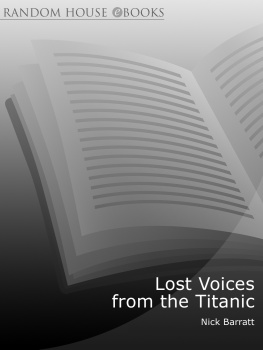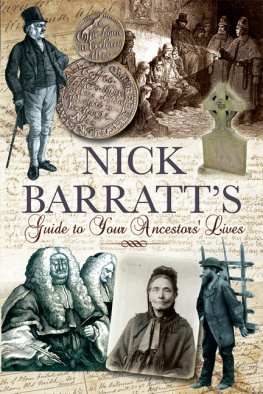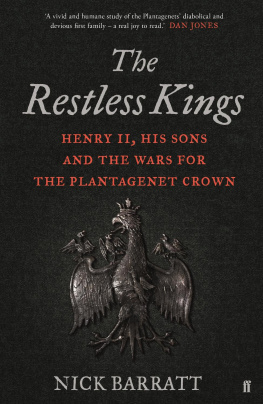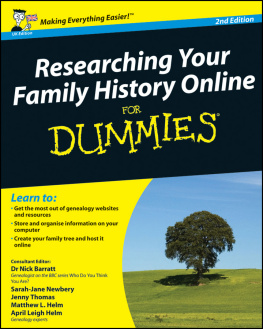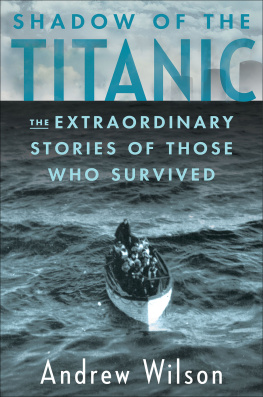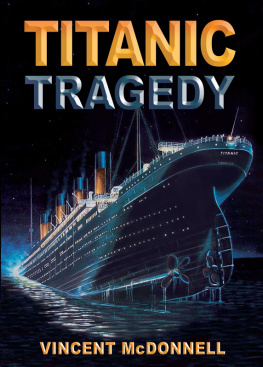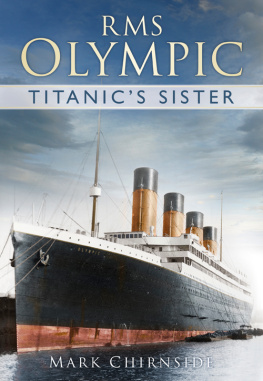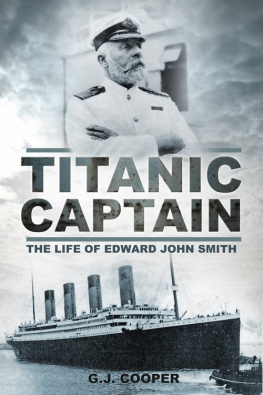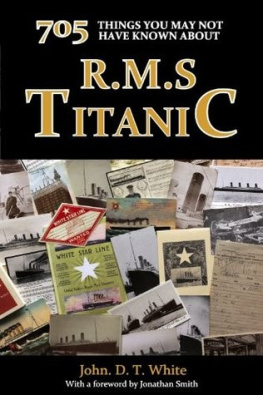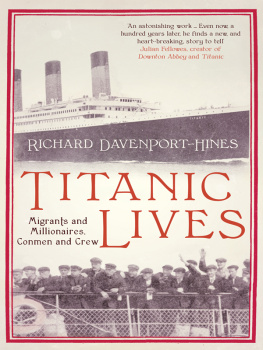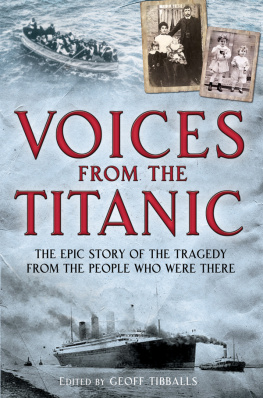About the Book
On 15 April 1912 the largest, most expensive, most luxurious ship ever built sank beneath the icy waves of the northern Atlantic. Over one thousand five hundred people perished. Award-winning historian Nick Barratt tells the story of the Titanic for the first time in the words of those who designed her, built her, sailed her and survived her.
This ebook is copyright material and must not be copied, reproduced, transferred, distributed, leased, licensed or publicly performed or used in any way except as specifically permitted in writing by the publishers, as allowed under the terms and conditions under which it was purchased or as strictly permitted by applicable copyright law. Any unauthorised distribution or use of this text may be a direct infringement of the authors and publishers rights and those responsible may be liable in law accordingly.
Version 1.0
Epub ISBN 9781409050216
www.randomhouse.co.uk
This paperback edition published by Arrow Books 2010
10 9 8 7 6 5 4 3 2 1
Copyright Nick Barratt, 2009, 2010
Nick Barratt has asserted his right to be identified as the author of this work under the Copyright, Designs and Patents Act 1988
This book is sold subject to the condition that it shall not, by way of trade or otherwise, be lent, resold, hired out, or otherwise circulated without the publishers prior consent in any form of binding or cover other than that in which it is published and without a similar condition, including this condition, being imposed on the subsequent purchaser.
First published in Great Britain in 2009 by Preface Publishing
Arrow Books
20 Vauxhall Bridge Road
London SW1V 2SA
An imprint of The Random House Group Limited
www.randomhouse.co.uk
Addresses for companies within The Random House Group Limited can be found at www.randomhouse.co.uk
The Random House Group Limited Reg. No. 954009
A CIP catalogue record for this book is available from the British Library
ISBN 978 1 84809 151 1
Contents
Preface
Outline
If you were to ask someone to name a famous ship from any period of history, you would almost certainly receive the instantaneous response Titanic. And if you then asked why they chose that particular ship, the words iceberg and sunk would not be far behind. There have been bigger, faster and more beautiful ships, but the story of the Titanic has been etched in our collective memory ever since Sunday 14 April 1912, when it collided with an iceberg en route to New York during its maiden voyage. The ship originally described as unsinkable by its owners and designers took just over two hours to fill with water, breaking in two and dragging over 1,500 souls to a watery tomb at the bottom of the Atlantic Ocean. What is perhaps most remarkable of all is not that so many died that night, but that over 700 people survived the sub-zero water and lived to tell the tale.
Lost Voices From the Titanic provides a definitive narrative of the disaster in the words of those who designed, built and sailed on the ship, as well as contemporary accounts from the resulting inquiry. Also included are articles from newspapers and journals, which took a morbid interest in the tragedy and its aftermath. It is a harrowing tale, combining incredible folly and unimaginable courage in equal measure, where eyewitness accounts from those lucky enough to survive will transport you back to those heartbreaking moments on that fateful Sunday night when families were separated for ever, and those left behind were forced to deal with the reality of their approaching death.
Historiography
The Titanic has been extensively written about over the years there are literally thousands of titles available, ranging from Walter Lords widely regarded A Night to Remember, published in 1955 and made into a film of the same name three years later, to the more recent Titanic Voices: Memories from the Fateful Voyage (1997), which focused on oral testimony and contemporary accounts centred mainly on the experiences of people from Southampton and its environs who were affected by the tragedy, and another anthology of archival material, The Titanic: Lost Words (2005). Public perception of the disaster in recent years has been primarily shaped by dramatisations, such as James Camerons blockbuster film Titanic, released in 1997 and breaking box-office records at the time further proof of the ships continued allure down the ages. The defining image of the Titanic is now Kate Winslet and Leonardo DiCaprio standing on the prow of the vessel as it ploughs through the waves. Yet there is danger in combining historical fact with fictional characters to create drama, as it becomes much harder to separate myth from reality in the public mind, a feeling succinctly expressed in David Mitchells novel Cloud Atlas:
The workings of the actual past and the virtual past may be illustrated by an event well known to collective history such as the sinking of the Titanic. The disaster as it actually occurred descends into obscurity as its eyewitnesses die off, documents perish and the wreck of the ship dissolves in its Atlantic grave. Yet a virtual sinking of the Titanic, created from reworked memories, papers, hearsay, fiction in short, belief grows ever truer. The actual past is brittle, ever-dimming and ever more problematic to access and reconstruct: in contrast, the virtual past is malleable, ever-brightening and ever more difficult to circumvent / expose as fraudulent.
The role of the academic historian is to sift through evidence and compile a narrative, timeline or thesis. However, an attempt to produce an account as close as possible to what actually happened, no matter how well intentioned, not only becomes harder to achieve as time passes and eyewitnesses either change their views coloured by subsequent media coverage or influenced by reflecting on other accounts of the event or die out, but is also affected and shaped by what the historian considered happened: a type of natural bias. On the other hand, when dealing with a topic that is as famous as the Titanic it is important to recognise that certain sections of the story are already well known because of previous media attention, and not only retell these passages but also challenge preconceived ideas. Furthermore, the standard narrative account of the Titanic starts and ends with the maiden voyage, the iceberg and the rescue operation by the Carpathia because these are the dramatic events that people remember. This is reflected in many of the publications on offer in bookstores, and increasingly online, which focus on April 1912 and the following months combining pictures and eyewitness accounts of that fateful night. As Walter Lord explained, when writing on 26 June 1955 to Mrs Helen Melville Mel Cooke, daughter of the Titanics Captain Edward John Smith, he saw his role when compiling A Night To Remember almost as a that of tour guide to the past: I just want to recreate the night the Titanic went down so that anybody can picture exactly what it was like. I want to re-capture all the little incidents and details. I want to preserve all the drama, excitement and courage that blended with the ice and the stars to make this night so utterly unforgettable. People are growing old now, and I want to do all this before the story fades away. (LMQ/7/1/18, National Maritime Museum) Yet the legend of the Titanic is equally shaped by public expectations of the ship before it set sail. These were based on context and circumstance that needs to be explored to fully understand why the news of its demise created such a reaction; and why the consequences of the disaster were so far-reaching.
Next page
